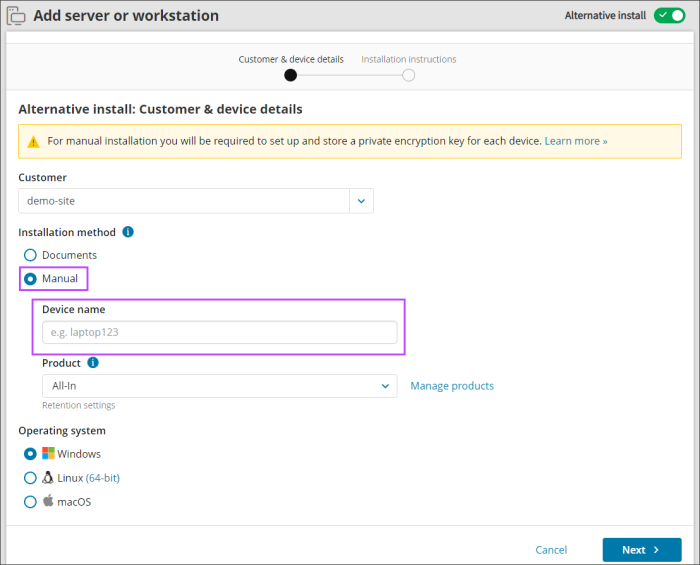We strongly do not recommend downgrading Backup Manager to a lower version after installation is complete. In cases where the Backup Manager has been downgraded, we cannot guarantee the application will function correctly.
To start using the Backup Manager, using the Manual Installation method (also known as Legacy Install) for your operating system, this wizard guides your through several quick steps.
Step 1: Add device
- Log in to the Console under a SuperUser account belonging to a reseller or end-customer
- Click Add devices, select Servers of Workstations
- Using the toggle in the upper right-hand corner of the wizard, enable Alternative install
- Select the Customer to install the device for from the dropdown
- Choose the Manual Installation method
- Give the device a memorable name
- Select a Retention Policy to apply to the device
Previously created Products may also be used, though we would recommend switching to Retention Policies at your earliest convenience.
- Select the operating system
- Click next
- Download the Backup Manager installer
- Run the installer and follow the instructions provided on screen
You will need the Device name and Installation key for installation, so it is recommended you take a copy here, though these can be found at a later date from the device properties Settings tab if this is closed before taking a note.
If the installer does not run after downloading and attempting to run, check the properties of the install file to ensure that it has not been blocked by your system upon download or attempt to run as the Administrator on the device.
Step 2: Language settings
The Backup Manager is available in many languages. Choose the language for the current installation.

Step 3: Personal access
Enter your access details for the Backup Manager. Your device name and installation key is required.
If you need access details, please contact your system administrator or service provider.
Step 4: Encryption Key/Security Code
Set a Encryption Key/Security Code that will be used to encrypt your data.
It can be any word or sentence of your choice, but should be secure and not easily guessed. Using this secret code, you can encrypt your files with a strong encryption algorithm, thus keeping your private data protected from unauthorized access.
The most important challenge is finding the best code, the one that you can remember but that no one else knows or can guess. There is an encryption limit of 100 characters for the Encryption Key/Security Code.
If you use the Encryption Key/Security Code method, you MUST remember this. We do not store this code anywhere for you, so please ensure you keep it safe, stored somewhere other than on this device. It will not be possible to restore your backed up data or re-install the current backup device without it.
Step 5: Schedule your backup (optional)
You can specify at what time to start regular backups and choose appropriate frequency.
Step 6: Report via email (optional)
Enter your email address to start receiving email reports on the statuses of recent backup activities. The frequency of report delivery is customizable.
Step 7: Automatic selection for backup (Windows workstations only)
You can quickly populate your backup selection with documents, images and videos detected on your computer.

You can change your initial choice of the file groups after the installation as well as refine your backup selection.
Ensure you enable Full Disk Access for the Backup Manager before running backups on macOS 10.14 Mojave or later.





